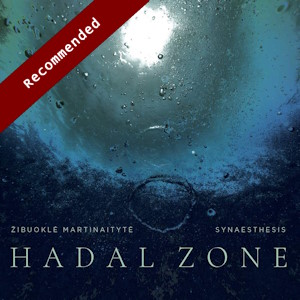
Žibuoklė Martinaitytė (b.1973)
Hadal Zone
Ensemble Synaesthesis
rec. 2021, Vilniaus Plokšteliu Studija, Lithuania
Reviewed as a digital download from a press preview
Cantaloupe CA21182 [64]
Layered like the deep ocean it travels through musically, Žibuoklė Martinaitytė’s astonishing work Hadal Zone can be view as a ritual, as therapy, as a portrait of nature or, she puts it herself in her self penned notes, an act of “making darkness visible”. The title refers to the deepest parts of the earth’s oceans, between four and six kilometres below the surface of the sea and derives from Hades, the underworld of Greek mythology, so inhospitable are such regions. The five sections of the piece evoke a descent through the various layers of the ocean until this final abyss is reached. Since light very quickly fails to reach these deeper zones, Martinaitytė chooses to represent the resultant darkness through the extreme bass end of the musical scale. Using electronics, she goes further than the audible range of even the lowest instruments such as the contrabassoon, into the realms of low frequencies which are more experienced through the body than through conventional listening.
The result of all this is a work as strange as the deep world it evokes. The traditional instruments used are all at the lower end of the range such as the tuba, the bass clarinet and so on. Whilst details do emerge like the strange luminescent marine creatures that inhabit such places, most of the music is murmurous and suggestive, as much sound as music in any traditional sense.
By rights all of this ought to be ghastly. A gloomy mess of bass register muttering. But in practice it is anything but. The reason is that Martinaitytė exploits a whole range of musical or sonic procedures that have dramatic effects on the human psyche. It has been known for some time for example that there is a connection between Neolithic sites such as Stonehenge and the phenomenon of low frequency sound. Experiments have shown that this type of sound induces euphoric, visionary states in those who experience it. The human voices used incorporate elements of chant similarly associated with physical and psychological states of relaxation marked by reduced blood pressure, calming of the heartbeat and deeper breathing. Such states are also associated with particular vowel sounds (here carried by the brass and woodwind instruments), most famously the Om chant of Hinduism. More conventionally, the slow, quiet music which evolves slowly over the piece’s hour long duration has a stilling effect on the mood of the listener.
With this predominance of bass notes, inevitably the music is ripe with overtones, those spectral, unacknowledged companions to all music. The lower the note the longer and richer the overtone series that ascends from it every time that note is played. Normally these overtone series are covered over by higher pitched elements of the music but in the absent of such higher pitches, the overtones take centre stage – another way in which musical darkness, so to speak, is made visible/audible. The use of harmonic or throat singing further augments this key, magical element of the musical texture.
The next logical question is: does this piece as a listening experience add up to more than just a number of theoretical ideas?
As someone whose day job is as psychotherapist, I am very interested in the therapeutic aspect of music. I believe that listening to music, any music, is therapeutic but it is clear that some elements do provide huge benefits to the listener. Think of Haydn, the greatest intuitive understander of musical psychology, writing about how he imagined his symphonies would help listeners whose minds had been disordered by the raucous world of London in the late eighteenth century. Given this interest I found the effect of listening to this piece quite remarkable. Instead of gloom, it left me uplifted and relaxed as if in listening I had shed the troubles of day to day life. Obviously such music can’t address the problems of life but it can help put us into a better state to address them.
It would wrong to suggest that this is just a glorified psychological experiment. The breadth and – if you’ll pardon the pun – depth of Martinaitytė’s imagination bring all of these procedures to vivid musical life but also take us to the extreme of human experience in an electrifying way. The music can stand alone as an evocation of a voyage to the bottom of the ocean.
Last year I enthused about Ondine’s collection of Martinaitytė’s orchestral music and spoke of her as having taken a step up to the top table of the most interesting composers working today. This extraordinary new work can only cement and expand that status.
David McDade
Help us financially by purchasing from





















